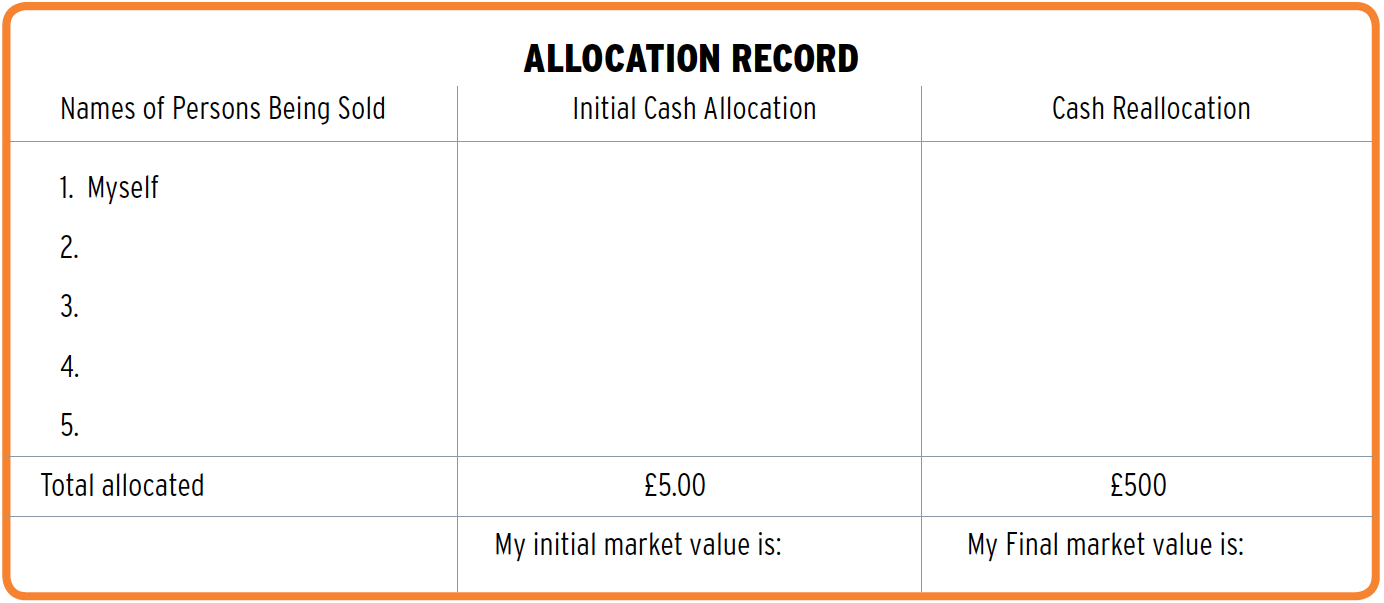BRIDGING – ATTRACTING
4 people
No facilitator input needed
120 minutes
- Preparation: 10 minutes
- Exercise: 50 minutes (maximum)
- Review: 1 hour
Instructions
Preparation (10 minutes)
Appoint a timekeeper, and adhere to the time schedule.
Prepare to be a “self-promoter.” Think about personal or professional attributes that you can “sell” to others – your “Personal Portfolio.” Include skills, experiences, expertise, the kinds of work or services you can provide, the ways you might help other group members benefit from this Program, and so on.
Decide which attributes to highlight in your presentation in Step 2. Answer the following questions:
- Influence Objective(s)
- Influence Style or Behaviour you intend to practise
- Core Style Statement
Group Exercise (30 minutes maximum)
Each group member contributes five pounds to a “Central Fund.” (If you wish, the fund can be administered by your facilitator).
Group members have a maximum of 6 minutes each to make their presentations:
- 4 minutes maximum: Present your case.
- 2 minutes maximum: Other group members ask you questions.
- 6 minutes total time
The timekeeper should vigorously enforce these time limits.
Now, start your recording.
After each presentation, including your own, allocate a portion of your five pounds Central Fund contribution to the person who has just presented.
The amount you allocate should depend on how impressed or convinced you were by the presentation – including your own.
Record the amount you wish to allocate in the “Initial Cash Allocation” column of the Allocation Record. (Do not remove the actual money from the Fund at this time.)
You may adjust your initial allocations as the presentations progress.
Determine the Initial Market Value of your Personal Portfolios (5 minutes)
Continue video recording.
Group members should now share their allocations with each other. Group members should total the amount allocated to their Personal Portfolio by all group members (including themselves). Note this total as the “Initial Market Value” of your Personal Portfolio.

Increasing the Market Value of your Personal Portfolios (5 minutes)
Continue video recording.
Now, each person has 2 minutes to try to increase the market value of one other person’s Portfolio. You will promote and sell that group member’s Personal Portfolio, based on what you know, believe, or heard during the first presentation.
Each group member’s Personal Portfolio may be “upsold” and promoted only once. You may not attempt to increase the market value of someone’s Personal Portfolio if another group member has already tried to do so.
Determining the Final Market Value (5 minutes)
Continue video recording.
After all second presentations are completed, all group members reallocate their contribution to the Personal Portfolios – as they see fit. During this second round of allocation, you may not change your initial investment in your own Personal Portfolio or in the person’s you promoted.
Group members should total the new allocations to their Personal Portfolio by all group members (including themselves). Note this total as the “Final Market Value” of your Personal Portfolio.
Stop the video recording.
Distributing the Central Fund (5 minutes maximum)
Group members now receive an amount of money from the “Central Fund” equal to the Final Market Value of their Personal Portfolios, based on the reallocation.
Now, compare your Portfolio’s Initial Market Value to its Final Market Value:
- If your Portfolio’s market value has increased, you must pay the amount of the increase to the person who successfully “upsold” your Portfolio and raised its value.
- If your Portfolio’s market value has decreased, the person who lowered its value must pay you the difference between your Portfolio’s Initial and Final Market Value.
Review
(60 minutes)
Prepare to review the tape recording of your exercise by sharing your Influence Objectives and the Influence Styles and Behaviours you intended to practise.
Now, play the tape and assess your Influence Behaviour. Use an Exercise Review Set at the back of your journal, code Influence Styles on the Tally Sheet. As you review the tape, give each other constructive feedback. Focus on the effectiveness of each person’s use of Influence Styles. Consider:
Persuading: How well did the presenter depend on logical facts and arguments to make a case? To what degree were the reasons effective in influencing others? Was the evidence tailored to anticipate the audience’s issues and concerns? How sensible, concise, and relevant were the facts and reasons?
Asserting: How well did the presenter state goals and expectations regarding a Personal Portfolio’s market value? How effectively did the presenter use positive and negative personal evaluations, or make exchanges or use pressures? To what extent did the presenter try to form coalitions or make deals with others?
Bridging: How well did the presenter try to involve others, draw them out, and determine their interests and concerns? How effectively did the presenter listen carefully to questions, comments, or counter arguments; test for understanding; or show concern? To what extent did the presenter use Disclosing to build trust and acceptance?
Attracting: How effectively did the presenter talk about future possibilities, as if that future had already occurred? How well did the presenter convey enthusiasm and get others enthused, or identify and build on the group’s shared values and goals? To what extent did the presenter use vivid, colourful imagery and compelling language and gestures?
After you have finished giving and receiving feedback, take time to record useful feedback and learning in your Journal
